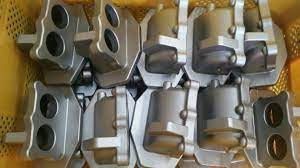Precision casting, also known as investment casting or lost wax casting, is a manufacturing process used to create complex metal components with high accuracy and surface finish. It is widely employed in various industries, including aerospace, automotive, defense, and jewelry.
The precision casting process begins with the creation of a wax pattern, which is an exact replica of the desired metal part. This wax pattern is typically produced using injection molding techniques or by hand. The pattern is then attached to a wax gating system, which includes channels and gates that allow molten metal to flow into the mold cavity and air to escape.
Once the wax pattern and gating system are complete, they are assembled onto a central wax sprue to form a cluster. This cluster is then coated with a refractory material through a series of ceramic shell building steps. The refractory coating is built up layer by layer to create a ceramic shell around the wax pattern.
After the ceramic shell has been formed, it is cured, typically by heating it in an oven or furnace. This process removes any remaining moisture and hardens the ceramic shell. Once cured, the ceramic shell is heated again to a high temperature, causing the wax to melt and flow out of the shell, leaving behind a cavity in the shape of the desired metal part.
The next step is the pouring of molten metal into the ceramic shell. The metal is heated to its melting point and poured into the shell through the gating system. The metal fills the cavity left by the melted wax, ensuring that it takes on the exact shape and details of the original pattern.
After the metal has solidified and cooled, the ceramic shell is removed, typically by vibration or water blasting. The resulting metal casting is then cleaned to remove any remaining ceramic material and excess metal, and it undergoes various finishing processes to achieve the desired surface finish and dimensional accuracy. These processes may include grinding, machining, heat treatment, and surface coating.
Precision casting offers several advantages over other manufacturing methods. Firstly, it allows the production of complex parts with intricate details and fine features that would be difficult or impossible to achieve using other processes. It also provides excellent dimensional accuracy and repeatability, ensuring consistent quality across multiple parts.
Furthermore, precision casting offers a wide range of material options, including ferrous metals (such as steel and stainless steel), non-ferrous metals (such as aluminum, bronze, and copper), and even exotic alloys. This versatility allows manufacturers to choose the most suitable material for the specific application, considering factors such as strength, corrosion resistance, and thermal properties.
Moreover, precision casting is a near-net-shape process, meaning that it minimizes the amount of material waste compared to other manufacturing techniques. This not only reduces costs but also contributes to sustainability and environmental conservation.
In conclusion, precision casting is a sophisticated manufacturing process that enables the production of complex metal components with high accuracy and excellent surface finish. By utilizing the lost wax casting method, manufacturers can create intricate parts with minimal material waste, offering a cost-effective and environmentally friendly solution for various industries.


No comments yet